Make a submission!
Submission deadline 19th August 2021, 5.30pm
What you need to include in your observation
To send a valid observation online to An Bord Pleanála, you need to:
- put your observation/submission in writing (either typed or handwritten).
- state clearly your own name and postal address in the observation.
- If a planning agent is acting for you in this observation, the agent must clearly write their own name and postal address as well as your name and postal address.
- give us enough details to identify the application you wish to make an observation on:
Case Reference number: TA29N.310860
Address: Holy Cross College, Clonliffe Road, Dublin 3 and Drumcondra Road Lower, Drumcondra, Dublin 9
You must have access to a debit or credit card and be ready to pay the correct fee.
- strategic housing observation - €20
- strategic housing observation and oral hearing request - €70
Tip: if €20 is too much for you, why not club together with a neighbour to make sure your voices are heard.
What's expected
To give you a clear idea of what's expected, here are pictures of the pages of the Word document
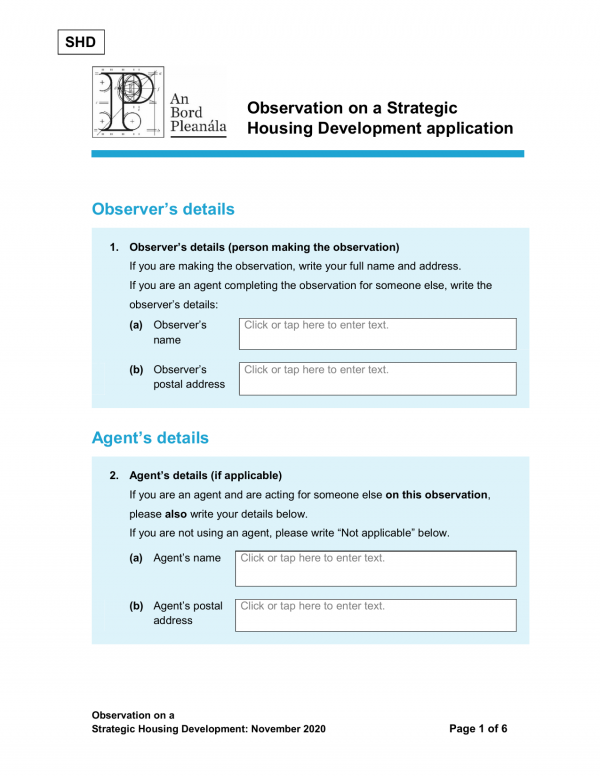
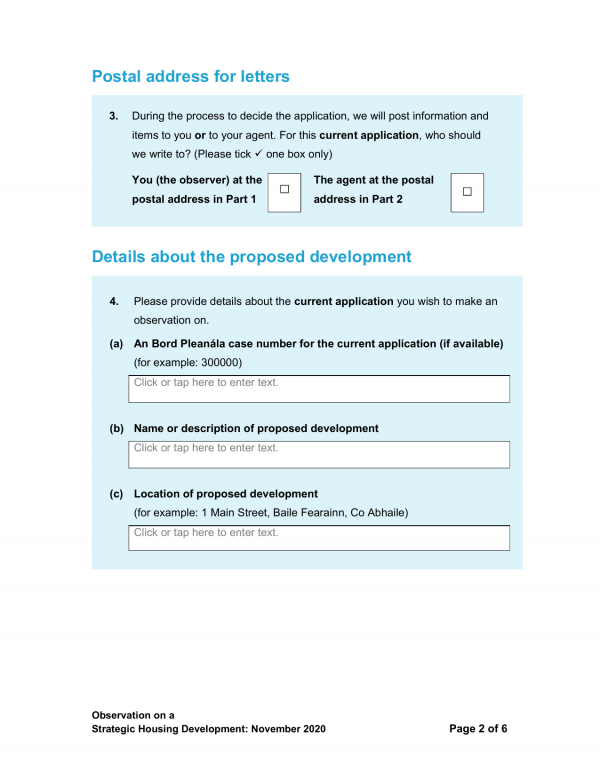

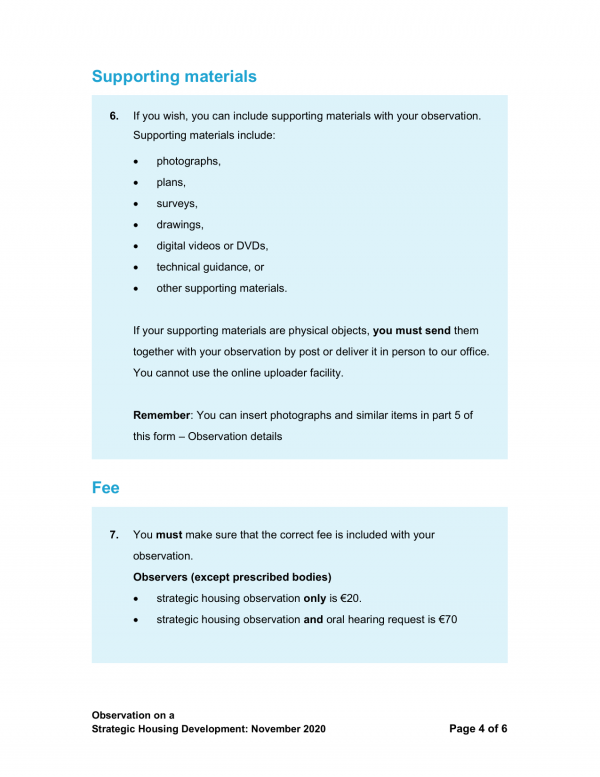
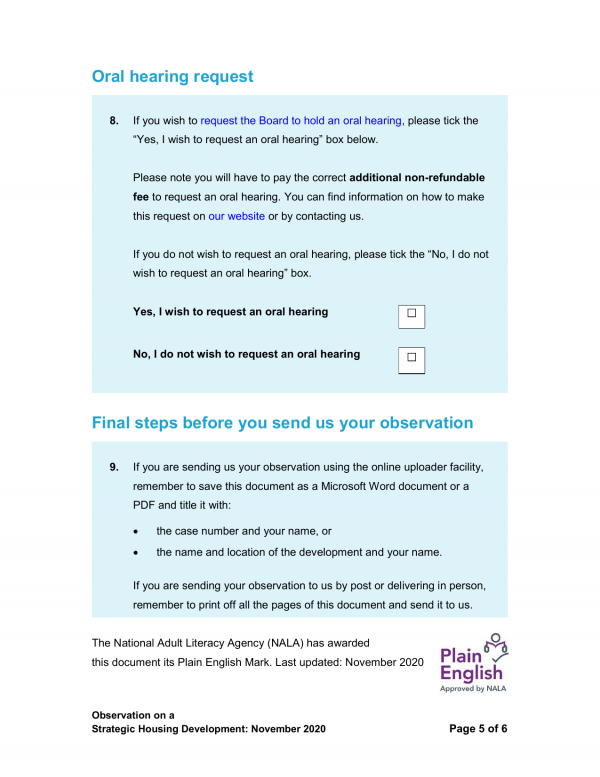
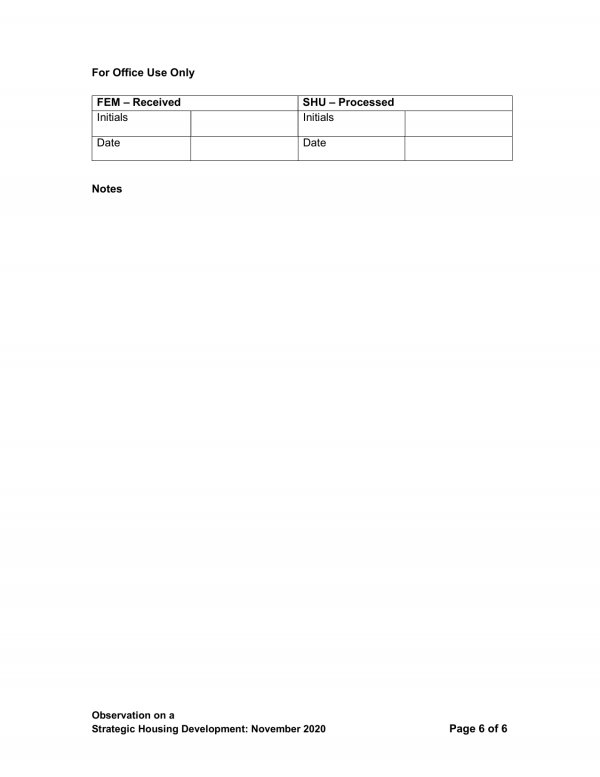
Word document
- The easiest way to make your submission is to download the Word file - Observation form
Handwritten options
- A fully handwritten observation seems to be acceptable. Make sure you quote the Case Reference number, and just for good measure, the address of the development (both given above). And don't forget to sign it and add your full address including Eircode.
- Printing out the form and filling it out by hand is also an option. Here is the file as a PDF
Submitting your application
Online
The website seems to suggest that your document can only be submitted online (it mentions no other option).
You will need to sign and scan the signed document. You will also need to scan all of your supporting documents.
- if you have no scanner please contact us
- it seems the application form AND the supporting documents must be submitted as a single file only
- the size of this single file may not exceed 10MB
- the name of the file must be of the format:
- TA29N.310860 - Ann Duine.docx, or
- Holy Cross College, Clonliffe Road, Dublin 3 and Drumcondra Road Lower, Drumcondra, Dublin 9 - John Murphy.pdf
(where Ann Duine or John Murphy is your name!)
File size limit
If your file size is over the maximum allowed 10MB - consider using a web service such as Adobe Compress PDF to reduce the size of your pdf.
- we have Adobe Acrobat and can use this to shrink the file for you - if you trust us to do so - just get in touch
Online submission address
The online submission address is https://online.pleanala.ie/en-...
In person / by post
The form itself suggests your submission can be delivered in person or by post:
"If you are sending your observation to us by post or delivering in person, remember to print off all the pages of this document and send it to us."
- the address is: An Bord Pleanála, 64 Marlborough Street, Dublin 1, D01 V902 - opening hours 9.15am to 5.30pm Monday-Friday - closed on Weekends.
- payment by post - include a postal order or cheque for the correct amount
- payment in person at reception - either cash or credit/debit card
- if sending by post, the use of registered post is recommended
- date of arrival of your letter must be on or before the deadline date - Aug 19th, at 5.30pm
Our simple templates
Bare bones template to get you going:
Sample submissions
Here is an already submitted submission - it serves as a good template - but remember to use your own words, and express your own concerns:
- Neasa Hourigan - Greens - https://neasahourigan.com/docs...
Points to consider
Below are some points you may wish to consider. Take a look at the Stories section for local background to some of the points. (If you have more ideas/points that do not appear below - please get in touch).
Please also make sure to write your submission using your own words - please don't just copy and paste sections of the text below. An Bord Pleanála will not take (e.g.)80 submissions all using the same text seriously.
This diagram provides a good overview of the problems with Strategic Housing Development(SHD) developments in Dublin - the types of building it promotes and problems with the process:
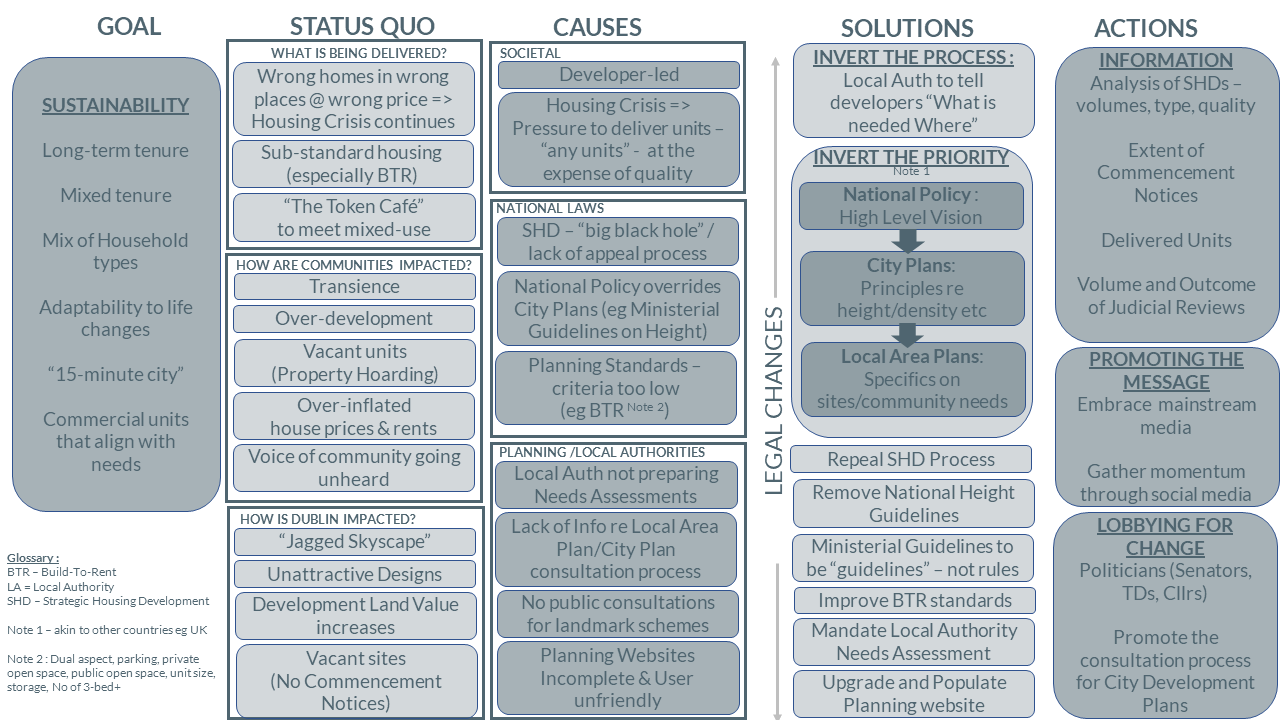
This diagram is taken from the Dublin Democratic Planning Alliance website at ddpa.ie which itself contains many points to consider - Building better communities, Sustainable density in Dublin etc.)
In our development the issues are of sheer scale, height(the towers are higher than originally proposed), the quality, the size of the flats themselves, community, parking, ownership... etc. and in particular access and amenities.
In short:
* we will have at least 3471 new neighbours (up to 4011 if double occupancy of single person studios is permitted)
* there will be provision on the site for 500 car parking spaces
* building will entail 46,000 truck movements
* the new towers are higher than originally presented - totally out of character with Drumcondra - and goes against existing Dublin City Development plan
* 70% of the development will be of single occupancy or 1-bed flats (the usual standard is 25% max). This mix not conducive to building a community
* the flats are much smaller than the usual permissible size - they represent a kind of intensification (and you are the chicken!)
* the local infrastructure, transport, traffic, shopping, schooling... is already at breaking point
* access is promised but not guaranteed - access to what exactly? access 24hr?
* minimal public consultation - many neighbours have no idea about what has been proposed
* less invasive plans not considered first - e.g. enlargement of existing housing
In response to recent meetings online Hines themselves issued a clarification document which we address here
More detail:
- the surprising idea that Dublin would sacrifice green parkland so close to the city center when other cities would give everything for such a space.
- to remind you what is being lost, please see the Gallery - it is true that not all lands will be built over - but much of it will (including on what are now playing fields/flood plains to the north and west) and the immense uninterrupted skyline, the sense of space, will be gone forever
- these pictures from the developer show, the extent of the development and how views will be impeded (a side elevation from the Tolka river is has not been found yet - will be added if available)
- tree cover in the Dublin City Council area is already well below that to the south
- issues with Build to Rent !
- undemocratic nature of SHDs
- ABP is obliged to pass almost any plan. Checks and balances function undermined (see the D8 development and referral to the European Court below)
- minister has put himself/(Government has put itself) above the long established democratic planning process
- as the stories section of this website shows, local planning efforts go back 100 years
- risks to housing prices (escalation of land prices) of this kind of development
- no developer will want to build anything else, anything with lesser returns
- establishes a precedent - all future applications will refer to height already allowed
- rental inflation with a surplus of these types of units in this or any neighbourhood, etc,
- area already saturated with co-living and student blocks - and concomitant loss of amenities
- downward spiral of State impoverishment - the State is ostensibly too poor to build homes itself (as Marino was built last century). These developments extract vast amounts from the economy which could otherwise go to the Government. (This development alone will extract ca. 1 billion Euros from the economy in 30 years, whilst paying very little in taxes). Leaving Ireland in a progressively weaker and weaker position to tackle housing or any other problem.
- quality of architectural proposal
- I.e. dual aspect ratios, - those flats classed as dual aspect often just have "L" shaped windows
- 49% of the flats are single aspect (have only one window) - many(most - unclear?) of these have no balconies
- unit mix (70% single occupancy vs. the normal standard of maximum 25%) - makes community, family building difficult. Leads to transience. (The single occupancy flats are called "Studios" (very small) and "1 Bed" (these have a true separate bedroom)
- unrealistic enforcement of private car ownership limits for residents of the scheme, etc.
- Height
- best practice is to zone towers together in the city scape (assuming towers are needed at all)
- SHD leading to chaotic "jagged" city scape
- the towers in the plan now submitted are taller than originally presented, e.g. the main tower was 14, it is now 18 storeys high.
- fire department will need extra (taxpayer) funding to be able to tackle high rise blazes across Dublin
- Scale of the development
- at least 3471 new adults into an area poorly suited to ever more population increase
- see also points about transport infrastructure below
- schooling places already limited - e.g. problems with Coláiste Mhuire school, Parnell Square etc.
- size of the development and the emphsis on tiny single room occupancy
- known mental effects of living in high towers, in confined space, with single aspect light
- 70% of the flats are small, single occupancy hotel like rooms. The development could be converted to:
- a Hotel at a later stage or go
- straight to Airbnb
- either officially (already seen at Student blocks e.g. Dorset Point Ref: 3726/20)
- or unofficially - contracts are signed, but the signee immediately sub-lets to Airbnb. This has been a huge problem e.g. in the UK - with even social-housing parts of such developments never being moved into, just immediately sub-let.
- This leads to even more noise/nuisance than current the plan already entails - in a residential area
- such developments, built expressly to solve the housing crisis, should be subject to special rules in this respect
- some sort of mechanism (e.g. secure entry scanning) must be put in place
- developers themselves should subject to escalating fines so this planning condition is enforced
- Housing need - Developments under SHD can override standard mix ratios for studios to 1-bed, 2-bed. 3-bed. Traditional Dublin planning permit a maximum of 25% single occupancy or 1-bed units in any development. This ensures that as families grow they can stay in their community, keeping their friends and schooling intact, by moving to a larger local flat.
Hines claim they should be permitted to build 70% studios or 1-beds contravening these established planning rules because the local need (see their KPMG "Future Analytics" Housing Needs study(see from page 41)) is for studios or 1-beds.
In this study the existing population mix in Clonliffe really seems to be being used as the primary justification for the mix proposed in the development. e.g. 65% of people in Drumcondra live singly or as couples and so this alone fully justifies the 70% mix at the new development. The whole tenor of the document is that much needed relief is being provided.
There is no survey of how people would actually like to live. Small households are blamed e.g. on inevitable fertility loss. But a driving reason leading couples not to have children is the crippling cost of doing so. This development takes no account of the wishes or aspirations of the population in Clonliffe/Drumcondra. Many young couples would like to have a family. Older people love to have children in their neighbourhood. Instead of solving the problem of the area being unable to generate a good community mix, it seeks only to perpetuate the imbalance. Thought you could never found a family in Drumcondra, well, you still can't, but we did build 1610 new apartments. Fruitless activism? Entrenching a monoculture instead of providing much needed relief. - Old traditional mix standards were put in place for a reason. The assumption seems also to be that such single owner/occupiers will be happy to move into this development and so free up local houses. This seems unlikely - the new flats are too small and too expensive for such people to consider such a move. And, especially for such people, they would prefer to buy.
- Future proof - for a changing demographic - a ruse to get past planning restrictions on mix?
- "Hines said the proposed development responds to the demand and demographic of the area, where 51 per cent of households are either single occupancy or couples without children.
The apartment mix is future-proofed, it said, and the design can respond to market demand where two one-bed units could be converted into three-bed units." - from https://www.irishtimes.com/new... - Note how here Hines now suddenly talk of market demand rather than housing need.
- Any building can be converted - retrofittingis a question of expense and disruption. Will these new 3 bedroom flats now have 2 kitchens and 2 front doors? - Is this development any more future proofed than any other development? Hines provides no details to back up their statement. Can planning be permitted on this "70%" development, because the developers say, well, it is not really 70%.
- If 3-beds are possible, why not build them now instead? - Hines claim reasons of Housing Need (see above) but it is profit (which they call market demand) which guides them here. Simply put - they have calculated they will make more from renting 2 1-bed flats than 1 3-bed flat occupying the same area. But this calculation is "washed" with ideas of Housing Need.
- "Hines said the proposed development responds to the demand and demographic of the area, where 51 per cent of households are either single occupancy or couples without children.
- ACCESS - unclear "commitments" to rights of public access
- the problem is that other developments (e.g. the Baths at Clontarf) now have no public access despite this being a condition for planning to go through
- the next door development at the old religious Carmelite Convent in St. Alphonsus Road (Chapelgate) is completely gated and walled off
- access must be a public right - perhaps with escalating fines for any closures or some other mechanism - a public right of way must be laid down in law
- must be 24 hour, not time limited
- e.g. Grangegorman access is time dependent
- no building of any gates permitted - now or in the future
- gates can suffer "technical difficulties" denying access
- 20% of lands must be public access - 20% not clear from plans
- ACCESS - Permeability of the City -
- there is no bridge of any sort across the Tolka between Frank Flood Bridge (Drumcondra Bridge) and Luke Kelly Bridge. That's over 1.2 kms
- forcing ALL traffic to use these 2 narrow bridges including pedestrians and cyclists alongside gridlocked traffic...
- See the Green Network section for how long locals and Dublin have been trying to solve this problem since 1922!
- TRANSPORT infrastructure - whilst Hines supplied brochures speak of the development providing "...high-quality apartments at a central location, next to high quality public transport infrastructure..." we as residents know that the transport system in Drumcondra already overloaded
- the transport analysis in the development plan was made in March 2020 at the height of Covid (when there was no traffic)
- as locals,we know the buses and trains are usually full, they have no space - now add 4000 new commuters!
- traffic is grid-locked during the rush hour - (6.30-9.30 and 15.30 to 18.30 in "normal" times)
- Drumcondra Station can barely cope which current volumes, it needs to be rebuilt -
- for even the current density of users
- the coming expansion of Dart services to Maynooth,
- safety on GAA days
- the project should be obliged to provide relief for the pressure it will place on the transport infrastructure - for example a metro line branch to the Mater to connect with the new airport metro there.
- Traffic inside the development
- traffic inside the development can be reduced by simply placing car park entrances (to the underground garages) much nearer to the edge of the development - reducing noise, providing more peaceful recreational open space and reducing the risk of accidents
- traffic inside the development can be reduced by simply placing car park entrances (to the underground garages) much nearer to the edge of the development - reducing noise, providing more peaceful recreational open space and reducing the risk of accidents
- Pollution - Environment
- There are still no/have never been any long term pollution measuring stations along the Drumcondra Rd. There is no history of measurements, so there is no evidence base. No one can tell you whether the long term everyday pollution is already over European norms because it is not measured.
Until this base of evidence is available, and until pollution so revealed has been tackled, new projects such as this should not be permitted.
- There are still no/have never been any long term pollution measuring stations along the Drumcondra Rd. There is no history of measurements, so there is no evidence base. No one can tell you whether the long term everyday pollution is already over European norms because it is not measured.
- Preservation - Environment
- The lands along the Tolka have been used as a recreational park for many years. Initiatives to protect and link up the park to the Green Network along the Tolka have been proposed since 1922. What is being lost can be seen the in the Gallery. Not just the views, the open skies are being lost, but also, it is proposed, 40% of the existing trees. This report made by local resident David Denby details these trees and what their loss would mean for the area.
- Density needed - really?
- Dublin is already more densely populated than Berlin and Vienna, but without their underground system to alleviate pressure. Cities with higher density have sophisticated underground transport networks.
- indeed the original development of Drumcondra went hand-in-hand with an expanding tram network - the famed number 16 can still be seen on buses today.
- whole premise for SHD fast track is open question - since Covid/trend to home working and to University study online and the coming global corporate tax rate of 15%. What's needed in Dublin needs to be re-examined before such large projects go ahead
- 70m tower proposed as absolutely necessary... whilst local house owners not permitted to raise roof levels even by 20cm to make attics livable
- other less invasive ways to increase density not explored first
- truly evidence based approach is needed
- Dublin is already more densely populated than Berlin and Vienna, but without their underground system to alleviate pressure. Cities with higher density have sophisticated underground transport networks.
- Sport facilities mentioned originally, unclear from plans
- will the GAA fields be fenced off, as the Belvedere fields already are?
- will other public sports amenities be provided
- Ownership - Possibility that the secret sale of these lands by the Church was anti-constitutional and could potentially be unwound
Oddly, there is actually a provision in the Constitution that seems to suggest that this could not happen. Article 44.6 states: “The property of any religious denomination or any educational institution shall not be diverted save for necessary work of public utility and on payment of compensation."
From Fintan O'Toole on the development of Marino in Dublin / Irish Times Jul 24, 2021
Morally these lands should be completely given over to social housing of the quality and density Dublin was able to build last century, e.g. at Marino. The purchase of these lands was funded in post-famine Ireland from the last pennies of a poverty stricken people. Your relatives and mine - paid for this land. Their intention was not that it be used in this way.
Resources related to this development
- Councillors call Dublin build-to-rent scheme a ‘monstrosity’
Developer plans to build scheme of 1,614 apartments up to 18 storeys tall on Clonliffe Rd https://www.irishtimes.com/new... - ABP - Case details: https://www.pleanala.ie/en-ie/case/310860
- from the developer: https://holycrosscollegeshd.ie/
- Marie Sherlock: https://www.mariesherlock.ie/a.
Resources significant to this development
- RTE - SHDs - the housing 'quick fix' that's broken: https://www.rte.ie/news/primetime/2021/0706/1233466-shd-strategic-housing-developments-crisis/
- interesting because the Hines development in D8 has been refered to the European Court after a Judicial Review
- see: https://www.irishtimes.com/new...
- and https://www.rte.ie/news/dublin...
- and https://www.dublininquirer.com... interesting for the suggestion that there was an attempt by Hines to control the public hearing: "We have also compiled a list of questions which may be asked by members of the public regarding the development.”
- Dublin 8 Residents Association - https://www.facebook.com/Dublin-8-Residents-Association-100442658569408/

"We have been asking for months how a secret, undemocratic plan concocted between Dublin City Council and a private developer could overrule the statutory development plan our elected representatives had approved. It potentially exposes as quicksand the foundations on which all of this excessive height, build-to-rent and co-living have been constructed"
Dublin 8 Residents spokesman Joe Clarke.
- Is Build-to-Rent Crowding Out Other Kinds of Homes in Dublin?: https://dublininquirer.com/202...
General resources
- ABP - provide at hotline if you have any questions - call 01 858 8100 and ask for the SHD helpdesk
- ABP - https://www.pleanala.ie/en-IE/Observation-on-a-strategic-housing-development-app
- ABP - https://www.pleanala.ie/en-IE/Observation-on-a-SHD-Application-Public
- Neasa Hourigan: https://neasahourigan.com/post/planning-observation/
- CIS - (more general, not SHD specific) https://www.citizensinformation.ie/en/housing/planning_permission/an_bordpleanala_and_planning_objections.html
Local representatives
Find contact details for your local representatives and see what they have said.